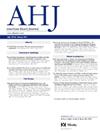All-cause mortality and death by aortic dissection in women with Turner syndrome: A national clinical cohort study
IF 3.5
2区 医学
Q1 CARDIAC & CARDIOVASCULAR SYSTEMS
引用次数: 0
Abstract
Background
Turner syndrome (TS) is a complex genetic disorder with raised mortality. Our objective was to investigate mortality and causes of death in TS.
Methods
A matched retrospective observational study of women with TS recruited from the Turner centers in Sweden were conducted. A total of 472 women with TS, ≥16 years old with a cytogenetically verified diagnosis and 2357 controls, matched for birthyear and sex, were examined and followed since 1995 for up to 26 years. Survival analyses were performed with Cox proportional hazard models. Kaplan-Meier curves were generated. Cumulative incidence rates were evaluated by competing risks analysis, using cumulative incidence function.
Results
During a mean follow-up of 17 years, 35 (7.4%) women with TS and 70 (3.0%) controls died. All-cause mortality was elevated in TS, hazard ratio (HR) 2.90 (95% CI 1.92-4.37), mainly due to circulatory diseases and notably aortic dissection, with HR of 9.11 (95% CI 4.54-18.25) and 21.79 (95% CI 4.62-102.82), respectively. Aortic dissection was the single largest cause of death in TS, accounting for 23% (8/35) of total deaths. Death by cancer or external causes were not raised in TS. In individuals below 45 years of age death, aortic dissections were greatly increased compared to controls, HR 55.59 (95% CI 2.33-1325.69). From the ages 46 to 80 years a notably higher risk of dying by heart diseases, aortic dissection excluded, was shown in TS compared to controls HR, 7.7 (2.65-22.36). The median survival time was 8 years shorter in TS compared to controls.
Conclusions
The increased mortality in TS was mainly driven by aortic dissections in the young and by heart diseases in the older. Healthcare professionals should prioritize detection and monitoring, with emphasis on cardiovascular diseases.
特纳综合征女性的全因死亡率和主动脉夹层导致的死亡:一项全国临床队列研究。
背景:特纳综合征(TS)是一种复杂的遗传性疾病,死亡率较高。我们的目标是调查 TS 患者的死亡率和死亡原因:我们对瑞典特纳中心招募的 TS 女性患者进行了一项匹配的回顾性观察研究。自 1995 年以来,共对 472 名年龄≥ 16 岁、经细胞遗传学确诊的 TS 女性患者和 2357 名出生年份和性别匹配的对照组患者进行了长达 26 年的随访。生存分析采用 Cox 比例危险模型进行。生成了卡普兰-梅耶曲线。使用累积发病率函数,通过竞争风险分析评估累积发病率:在平均 17 年的随访期间,35 名(7.4%)患有 TS 的妇女和 70 名(3.0%)对照组妇女死亡。TS患者的全因死亡率较高,危险比(HR)为2.90(95% CI 1.92-4.37),主要原因是循环系统疾病,尤其是主动脉夹层,其危险比分别为9.11(95% CI 4.54-18.25)和21.79(95% CI 4.62-102.82)。主动脉夹层是TS的最大死因,占总死亡人数的23%(8/35)。癌症或外部原因导致的死亡在TS中并不常见。与对照组相比,45岁以下人群的主动脉夹层死亡率大大增加,HR为55.59(95% CI为2.33-1325.69)。与对照组相比,TS 患者在 46 至 80 岁期间死于心脏病(不包括主动脉夹层)的风险明显更高,HR 为 7.7(2.65-22.36)。与对照组相比,TS患者的中位生存时间缩短了8年:结论:TS患者死亡率升高的主要原因是年轻人的主动脉夹层和老年人的心脏病。医护人员应优先进行检测和监测,重点是心血管疾病。
本文章由计算机程序翻译,如有差异,请以英文原文为准。
求助全文
约1分钟内获得全文
求助全文
来源期刊

American heart journal
医学-心血管系统
CiteScore
8.20
自引率
2.10%
发文量
214
审稿时长
38 days
期刊介绍:
The American Heart Journal will consider for publication suitable articles on topics pertaining to the broad discipline of cardiovascular disease. Our goal is to provide the reader primary investigation, scholarly review, and opinion concerning the practice of cardiovascular medicine. We especially encourage submission of 3 types of reports that are not frequently seen in cardiovascular journals: negative clinical studies, reports on study designs, and studies involving the organization of medical care. The Journal does not accept individual case reports or original articles involving bench laboratory or animal research.
 求助内容:
求助内容: 应助结果提醒方式:
应助结果提醒方式:


